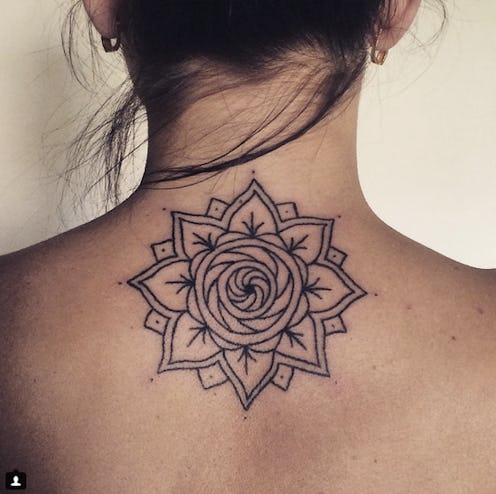Fashion
How To Get A Stick & Poke Tattoo In The Safest Way

In the game of tattoos, there are usually two ways to go: professional tattoos by a gun or stick and poke tattoos by a hand. If you're planning on taking the latter route, it's important to know the risks of getting a stick and poke tattoo. Taking the plunge into the world of sticking and poking can be exciting. It's cheap, easy, and oftentimes fun. But of course, there is a considerable measure of risk involved. As with all tattoos, aftercare and possibility of infection are important points to keep in mind.
Stick and poke tattoos are the definition of DIY, and therefore can imply rudimentary and often less than hygienic tools and methods. Because of that, you're taking more of a gamble with your health than you would with a tattoo that is done with a gun by a professional.
Before getting your first stick and poke, it's important to do plenty of research about the safest ways to go about it. DIY doesn't have to mean sketchy. When taking the proper measures necessary to ensure safety and cleanliness, and also taking care to use the right tools, stick and poke tattoos are a walk in the park. If you're diligent and keep your eyes open to facts on the Internet, signs from your body, and your own instincts, you can safely and successfully go about this adventure. Check out these safety precautions, and happy sticking and poking!
1. Sterilize Everything
If you're using a sewing needle, make sure it's relatively new and clean. Hold it to a flame to sterilize. Your best bet, in my opinion, is to invest in sterilized packaged needles. A needle that's cleaner and more specialized for the job would put most people's minds at ease.
As with regular tattoos, shaving the area before inking to avoid creating infections or in-grown hairs is a must. Wipe rubbing alcohol on the site, and use clean (ideally rubber glove-clad) hands. Never, ever, ever reuse needles! If you're unsure about supplies and such, you could always invest in a stick and poke tattoo kit. They can be a little pricy, but they're way worth the trouble, especially if you're expecting to stick and poke at a relatively frequent rate.
2. Use India Ink
Do not use just any old ink for your stick and poke. Ink, like the ink from your pen, is not sterile and can be highly toxic. A non-toxic ink, like India ink, would be your best bet. It's natural, carbon-based, and less likely to cause infection. India ink is super cheap, and you can buy tons of it at your local art supply store. Tattoo ink is ideal, but India ink is more easily accessible and just as safe.
3. Don't Push Yourself Too Far
While getting your stick and poke, it's very important to listen to your body. If it feels like your friend is pushing the needle in too far or is being too rough, speak up! Sometimes it's hard for an amateur artist to tell if they're going too far, and doing so could damage tissue and further expose your body to infection.
You should only be poking into the skin about an 1/8 of an inch. You should feel the pop of the skin as you pull it back out, but not so far that you're bleeding. If you bleed more than a few droplets during the process, or whatever you think looks excessive, your artist's method should be reevaluated.
If you're in an uncomfortable amount of pain or your skin is swelling up and reddening, take a break. Your skin won't be able to take much ink anyway when it's swollen. Re-sterilize the area, and wipe some witch hazel on the area to reduce irritation.
4. Opt For The Antibacterial Ointment
Some artists advise to skip the antibacterial ointment in order to avoid any lifting of the ink from the skin. However, you should always opt for antibacterial ointment anyway.
Since stick and pokes involve a million little needle pricks over and over, your skin is going to be pretty inflamed and possibly uncomfortable after the fact. Your skin is super prone to infection in this irritated state, and any precaution you can take to provide the area with some level of protection should be taken.
5. Treat It Like A Professional Tattoo
Aftercare is just as important with stick and pokes as it is with professional ink, if not more so! Make sure you use a thin layer of ointment for the first few days, and then switch to an unscented lotion like Cetaphil. Stick and pokes may not peel as much since the ink is not always very deep and the designs are usually thin-lined and simple.
However, still keep up with cleaning and moisturizing the area, as well as avoiding sun and submergence in water. You should be caring for your stick and poke tattoo the same way you care for your professional ink!
Images: holyinks/Instagram; locustbones/Twitter; Getty; stick_and.poke/Instagram